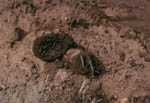Control
Growers should plant healthy seed potatoes and avoid the use of physiologically old seed. Cutting of potato seed has the disadvantage that the cutting process spreads diseases from contaminated to healthy tubers and exposes the cut surfaces of tubers to soil borne disease organisms.
Cut seed can be planted the same day in warm soil but for cold, wet soil conditions, cut seed should be cured first to heal the seed by storing at 10-15EC for 2 to 4 days under high humidity with good ventilation. Never store cut seed under closed, humid conditions. Seed cutting equipment should be sterilized or disinfected frequently, especially between different lots of seed potatoes. Hunter, Russet Burbank, Keswick and occasionally Sebago are quite susceptible to seed-piece decay.
Chemical treatment of tuber pieces is not a substitute nor a cure-all for the use of healthy, properly handled seed. Seed treatments (see Publication No. 1300A) will protect against some pathogens in the soil and on the tuber cut surface, but not from diseases within the tuber. Pre-storage treatment of seed with fungicides and again dusting with or dipping in fungicides immediately after cutting offers the best protection from tuber borne diseases.

